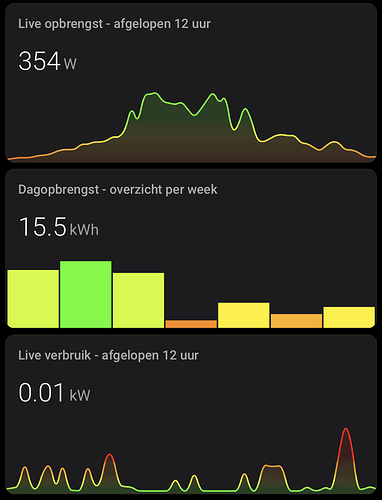Moved duplicate of [Mini-graph-card throwing errors on new value - #3 by VolkerRacho]
I have a pretty neat mini-graph-card setup,
but it creates errors in the browser log on every value update:
Fehler beim Verarbeiten des Wertes für ‘mask’. Deklaration ignoriert.
Fehler beim Verarbeiten des Wertes für ‘stroke-dashoffset’. Deklaration ignoriert.
graph.yaml:
type: custom:mini-graph-card
hours_to_show: 48
points_per_hour: 2
decimals: 0
hour24: true
unit: Watt
animate: false
line_width: 1
smoothing: on
# align_state: right
show:
icon: false
name: false
state: true
graph: line
fill: fade
points: hover
legend: true
average: true
extrema: true
labels: true
labels_secondary: true
name_adaptive_color: true
icon_adaptive_color: true
entities:
- entity: sensor.house_power
name: Gesamt
show_graph: false
color: orange
# - entity: sensor.energy_all_plug_devices_power
# name: Gesamt
# show_graph: false
# color: orange
- entity: sensor.gpc_power
name: GPC
# show_state: true
# show_indicator: true
color: red
- entity: sensor.server_power
name: Server
# show_state: true
# show_indicator: true
color: blue
- entity: sensor.salon_power
name: Salon
# show_state: true
# show_indicator: true
color: pink
- entity: sensor.waschmaschine_power
name: Waschmaschine
# show_state: true
# show_indicator: true
color: cyan
- entity: sensor.trockner_power
name: Trockner
# show_state: true
# show_indicator: true
color: orange
- entity: sensor.tv_sz_power
name: Tv SZ
# show_state: true
# show_indicator: true
color: yellow
- entity: sensor.energy_belkin_conversion_3dprinters
name: 3D Printers
# show_state: true
# show_indicator: true
color: purple
# - color: yellow
# entity: input_boolean.sleeptime
# name: Sleeptime
# show_line: false
# show_points: false
# show_legend: false
# y_axis: secondary
- color: gray
entity: sensor.sun_elevation
name: Sun
show_line: false
show_points: false
show_legend: false
y_axis: secondary
# state_map:
# - value: "on"
# label: Sleeptime on
# - value: "off"
# label: Sleeptime on
Also after a while the frontend becomes unresponsive, that is the reason I checked on this.
I tried removing all of the options:
type: custom:mini-graph-card
entities:
- entity: sensor.gpc_power
name: GPC
# show_state: true
# show_indicator: true
color: red
But also with this bare minimum I get these errors.
Does anyone have an idea?











